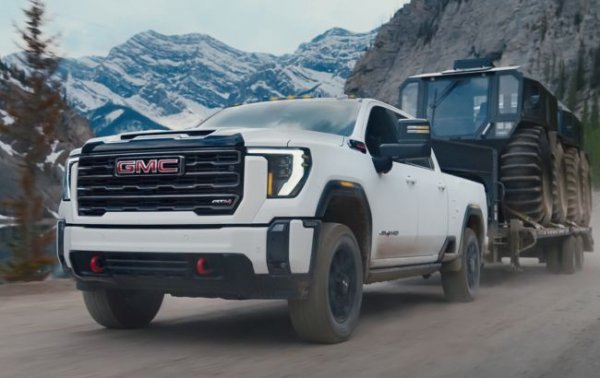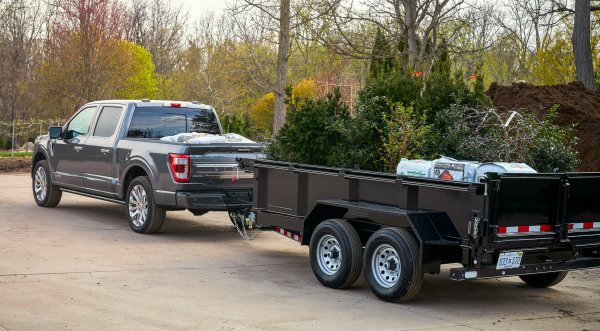
Photo: How to drive a car with a trailer (gmc.com) Author: Konstantin Shirokun
Almost every passenger car can tow a trailer, but not every driver knows how to do it. It’s not hard to learn, and RBC-Ukraine Auto journalists share several important rules.
Read about the main principles of driving a car with a trailer in the RBC-Ukraine article.
It is not without reason that separate chapters of the Road Traffic Regulations are devoted to towing a trailer, and in some cases it even requires a special category of license. An important difference is that a car with a loaded trailer behaves completely differently than a car with the same load inside the body. Therefore, driving a road train (and this is how Ukrainian traffic regulations classify a car with a trailer) must be learned both theoretically and practically.

Why is it worse with a trailer?
Yes, a trailer adds extra weight to the car and, figuratively speaking, its driver. Therefore, experienced drivers, even with a trailer, try to fit all the load in the car at the slightest opportunity and not to attach a heavy “tail” to the back. However, of course, there are cases when you can't do without a trailer: there are loads that are bulky, heavy, dirty, etc. This means that you need to be prepared to use a trailer, and to master this skill, you will have to learn a few things. And here are the nuances that need to be taken into account.
The car is now significantly heavier . With a trailer behind you, you will be driving a vehicle that is half as heavy as a single car. The increased weight is noticeable during a quiet ride, and during energetic maneuvers or in emergency situations the differences become simply critical. You should be prepared for this when you have to brake sharply or actively turn the steering wheel. In fact, ideally, such actions should be avoided.
The car is long and flexible . The trailer, despite the articulated joint, is one with the car, so all maneuvers are more difficult for the driver. A train twice as long makes it harder to back up and fit into narrow passages, but this is not the main threat. A long and “flexible” vehicle behaves unstable when moving quickly – both on the highway and on an uneven road. In particular, a road train can “swing” in the transverse direction or “fold” when braking. This factor also manifests itself when overtaking: since the dynamics of a heavy car will be worse and it is twice as long, you will be in the oncoming lane about three times longer.
Load placement . A light trailer is actually a semi-trailer, since its front part lies on the car. Therefore, it is important to ensure that the load is correctly positioned within the trailer platform. The load center should be on the trailer axle, or between the axles when the trailer has two close axles. If this rule is violated, the rear axle of the car will either be overloaded or unloaded. Both are bad, since they lead to impaired control of the car. It is very dangerous if the weight distribution is disturbed during movement, so the load should be securely fixed in the right place on the trailer.

Speed of movement . According to the Traffic Rules of Ukraine (clause 12.6 of the Rules), a passenger car with a trailer may not go faster than 80 km/h. And this is quite justified, given the risks mentioned above. For their part, experienced drivers believe that when towing a trailer, you must move at a speed at least 20 km/h lower than the speed of the car itself without a “tail” under the same conditions.
Category in the license . In many cases, when towing a trailer with a car, you can get by with a standard category B license. But for this, the actual mass of the trailer must not exceed 750 kg (clause 2.13 of the Traffic Regulations of Ukraine). In principle, you can tow a heavier trailer, but the car (empty), which acts as a tractor, cannot weigh less than the trailer, and the total mass of the road train cannot exceed 3,500 kg. These 3.5 tons are defined as the sum of the permitted maximum mass of the car and the permitted maximum mass of the trailer (according to the Cabinet of Ministers Resolution No. 340 of 08.05.1993).
In brief
In addition to understanding the physics of movement and knowing the rules of control, the driver also needs skills in driving with a trailer. These can only be obtained through subject training. And it is worth practicing not during specific transportations with a loaded trailer, but by arranging several special trips to a certain free area and to streets free of other transport.
Materials from Autocentre and Motor were used in preparing this article .
Let us recall that RBC-Ukraine recently reported why pedestrians are not always right.
